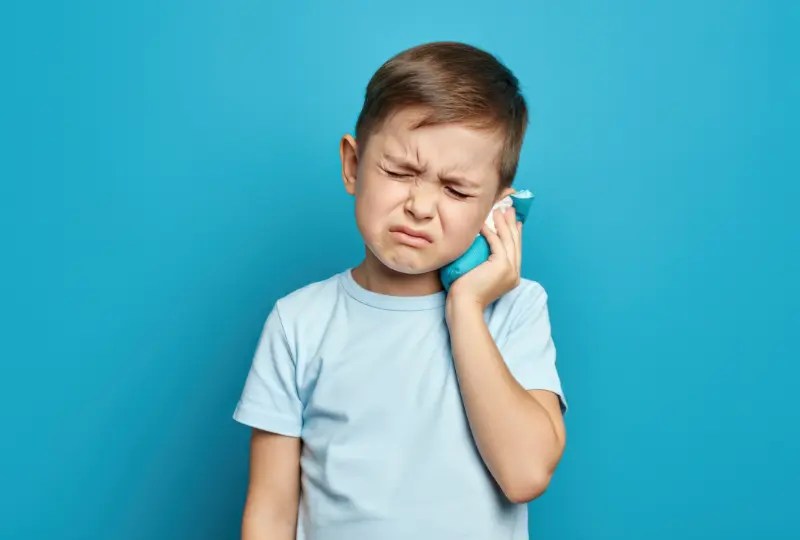As kids frolic in the pool on a hot summer day, the last thing they consider is an ear infection.
Yet, swimmer’s ear is a common issue that can turn aquatic fun into discomfort or pain in a heartbeat.
This guide explains swimmer’s ear, what causes it, why kids are especially vulnerable, and what parents and caregivers can do to prevent it.
What Is Swimmer’s Ear?
Swimmer’s ear — medically called otitis externa — is an infection of the outer ear canal. This is the tube connecting the outside of the ear to the eardrum.
The name derives from its association with water exposure. When water gets trapped in the ear canal, it creates a favorably moist environment for bacteria or fungi.
Symptoms of swimmer’s ear include:
- Itching in the ear canal
- Redness or swelling in the ear
- Drainage or discharge of clear or yellow fluid (eew!)
- Pain (which can worsen when the ear is tugged or pressed)
- Hearing difficulties due to blockage
What Causes Swimmer’s Ear?
Swimmer’s ear stems primarily from excess moisture in the ear canal, which creates conditions conducive to bacterial or fungal growth. However, other factors include:
- Frequent swimming or prolonged water exposure. The longer the ear stays wet, the more time bacteria have to multiply.
- Damage to the skin in the ear canal. Even minor abrasions from cotton swabs or inserted fingers can break the skin and invite infection.
- Exposure to contaminated water. Swimming in lakes, rivers, or unclean pools increases the risk of harmful bacteria entering the ear.
- Earwax blockages. While earwax is protective, too much buildup can trap water inside the ear.
Why Are Kids More Vulnerable to Swimmer’s Ear?
Children are highly susceptible to swimmer’s ear during summer or periods of frequent swimming.
- They have smaller ear canals which easily trap water.
- They tend to spend prolonged hours in water.
- They’re less cautious with hygiene practices like drying their ears after swimming.
- Certain activities like diving or underwater games increase the risk of water getting stuck in the ear canal.
How to Prevent Swimmer’s Ear
Thankfully, by adopting simple precautions, parents can ensure their child enjoys water activities pain-free.
1. Keep Ears Dry
- Use a towel or soft cloth to dry your child’s ears after swimming or bathing.
- Have your child tilt their head to each side to release trapped water from their ear canals. You can also gently tug their earlobe to help water escape.
- Consider using a portable ear dryer designed to remove moisture from ears.
2. Invest in Protective Gear
- Equip your child with swim caps or custom-fitted earplugs that keep water out of their ears. Silicone earplugs are particularly effective for kids who swim often.
3. Avoid Using Cotton Swabs
- Don’t insert cotton swabs or any small objects into your child’s ear, no matter how tempting it is to “clean” them. Swabs can push water or wax deeper into the canal, increasing the risk of infection.
4. Prevent Prolonged Swimming in Contaminated Water
- Always inspect the condition of swimming pools, lakes, or beaches before allowing your child to swim. If a body of water appears murky or polluted, avoid it.
5. Teach Good Hygiene Practices
- Educate your child not to poke fingers, pencils, or other objects into their ears.
- Encourage them to rinse their body and ears with clean water after swimming.
6. Use Preventive Ear Drops
- Over-the-counter ear drops containing acetic acid or alcohol help dry the ear canal and create an unfavorable environment for bacteria.
- These drops are beneficial after long swimming sessions.
- Consult a pediatrician if your child has a history of ear infections or a perforated eardrum.
7. Maintain a Healthy Balance of Earwax
- Earwax naturally helps block bacteria from reaching the deeper parts of the ear. Avoid excessive cleaning to preserve its protective function.
8. Take Breaks When Swimming
- Encourage your child to take periodic breaks during long swimming sessions to allow their ear canals to dry.
Addressing Early Signs of Swimmer’s Ear
If you notice your child scratching their ears constantly or complaining of mild discomfort:
- Dry their ear canals thoroughly after water exposure.
- Apply over-the-counter drying drops (if safe to use).
- Avoid swimming until symptoms subside.
If symptoms persist, it’s time to see a doctor to prescribe antibacterial or antifungal ear drops.
FAQs: Swimmer’s Ear in Kids
Q: Is swimmer’s ear contagious?
Swimmer’s ear isn’t contagious and cannot spread between friends, siblings, or classmates.
Q: Can swimmer’s ear occur without swimming?
Yes, swimmer’s ear can result from other causes, like using earbuds poorly or cleaning ears too aggressively.
Q: How long does swimmer’s ear take to develop?
It often develops within a day or two after water becomes trapped in the ear canal.
Q: Can my child swim while they have swimmer’s ear?
Your child should avoid swimming until the infection is fully healed to prevent further complications.
Q: Are certain kids more prone to swimmer’s ear?
Children who swim frequently or have small ear canals are likelier to develop swimmer’s ear.
Q: How is swimmer’s ear treated?
Doctors usually prescribe antibiotic or antifungal ear drops to clear the infection. Pain relievers might also be in order.
Q: How do I know if it’s swimmer’s ear or a middle ear infection?
Swimmer’s ear affects the outer ear canal, while a middle ear infection involves deeper structures. A doctor can identify the difference.
Q: Does earwax increase the risk of swimmer’s ear?
Excess earwax can trap water in the ear canal, but a healthy amount of wax can protect against infections.



Leave A Comment